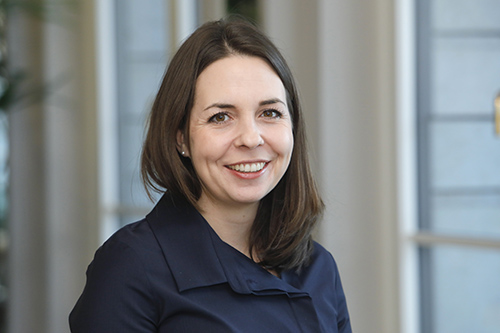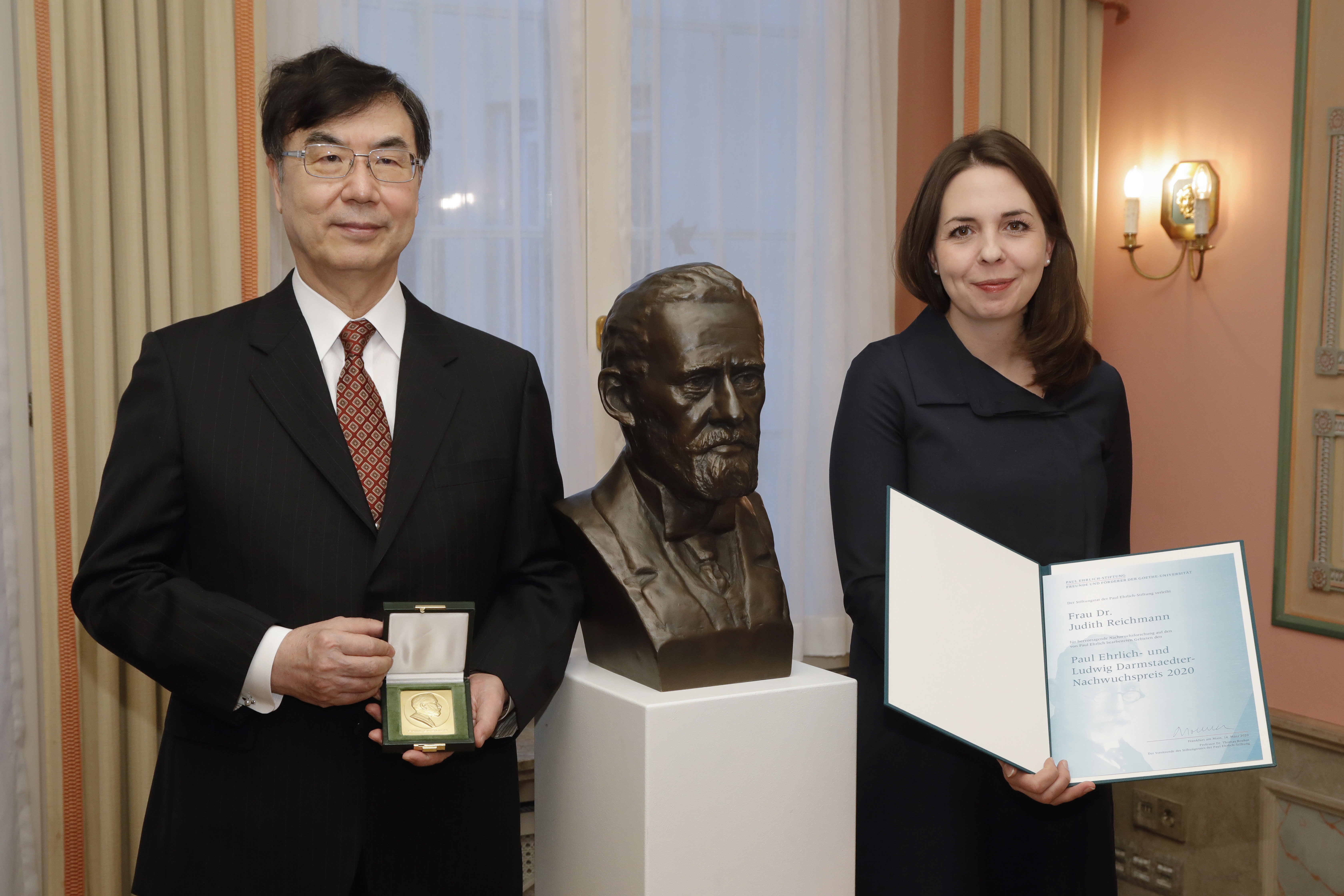- GU Home
- Paul Ehrlich Foundation
- Early Career Award
- Early Career Award 2020
Prize Winners of the Paul Ehrlich and Ludwig Darmstaedter Early Career Award 2020


Complicated choreography at the start of life
Before new life is created, gametes with a single set of chromosomes must form. The number of chromosomes would otherwise double with each generation, which would be incompatible with life. The double set of chromosomes is reduced through what is known as meiosis or reduction division..
In human oocytes, meiosis begins during embryonic development in the womb and stops four days after birth. It only resumes and is completed with the onset of ovulation in puberty. Women's ovaries thus store hundreds of thousands of oocytes whose meiosis was interrupted and which have to faithfully maintain this state for decades to come. An added difficulty is the fact that this interruption occurs at the very point where the chromosomes have paired and chromosome segments are exchanged. This exchange leads to a mixing of the genetic material; along with the halving of the chromosome set, this recombination is one of the most important outcomes of meiosis. The longer this intermediate state continues, that is, the older the oocytes are and thus also the woman is, the more the chromosomes tend to drift apart because the stabilising proteins gradually fail to do their job. As a result, errors occur in the ensuing reduction division. That is why the risk of pregnancies with an irregular number of chromosomes increases as women age, as is the case with Down syndrome..
Since reproduction in mice is robust, and meiosis is interrupted for several months, Judith Reichmann has studied how these animals solve the problem of failing reductive division, in the hope of learning something about human reproduction. She was able to show that mice produce a protein called Tex19.1, which indirectly stabilises chromosome pairing until meiosis is completed. If this protein is missing in the oocyte, there are many embryos among the offspring with too many or too few chromosomes. Tex19.1 thus makes sure that the offspring have the correct number of chromosomes even though meiosis was interrupted over a long period..
The protein is, however, capable of doing even more. It is also part of a system that guarantees the genetic stability of the sperm that develop out of the respective stem cells with the onset of sexual maturity. When sperm form, epigenetic marks are removed, making the genome totipotent again. As a consequence, however, the genome is defenceless in this situation and can be altered by retrotransposons present in the genome. Retrotransposons are mobile remnants of previous viral infections whose epigenetic packaging is normally so efficient that they cannot spread indiscriminately throughout the genome. However, if this tight constraint is lifted during meiosis, this can very well occur. Tex19.1 prevents this undesired effect and thus ensures that the sperm genome remains stable during meiosis. The protein is also responsible for a similar task in the placenta..
Two spindles instead of one.
Reichmann is also interested in what happens during the first cell divisions in mouse embryos and has made a remarkable discovery. She was able to show that the paternal and maternal chromosomes do not merge in the fertilised egg; rather, this happens only in the two-cell embryo. The two sets of chromosomes thus remain separate after fertilisation and during the first cell division. .
The reason for this is that – in the fertilised egg – the two sets of chromosomes are connected to two separate spindles after the paternal and the maternal pronuclei have dissolved, and not to just one as previously assumed. During a normal cell division, the chromosomes are arranged via a single spindle of tubes and filaments in the centre of the cell and then pulled towards the poles, at which point the cell then divides into two daughter cells. In the fertilised egg of the mouse, the paternal and maternal chromosomes are grouped separately via two spindles in the centre of the cell and then distributed to the poles. In the nucleus of the two-cell embryo too, the two sets of chromosomes initially remain in different hemispheres before they mix more and more with each further cell division. The two chromosome sets also appear to remain separate in human oocytes. However, whether this is also due to the formation of two spindles or another mechanism currently remains unclear. .
Reichmann's results are noteworthy in several respects. They provide a possible explanation why the chromosome sets are still arranged in different hemispheres after the first cell division. It had long been assumed that this had something to do with the embryo's further development. This is evidently not the case because the arrangement of the chromosomes can be traced back solely and exclusively to the two spindles. If two separate spindles also formed in the fertilised egg in humans, Reichmann's findings might explain why so many human embryos have two haploid cell nuclei instead of one diploid nucleus at the two-cell stage. If the chromosome sets in the two spindles are not positioned exactly next to each other, the chromosomes are not drawn to the poles in a straight path but at an angle. This leads to an increasing distance between the two sets of chromosomes, which then no longer find each other in the two-cell embryo and form two haploid cell nuclei instead of one diploid cell nucleus. .
A question for Germany's Embryo Protection Act.
Reichmann's results are also notable with regard to Germany's Embryo Protection Act. If the paternal and maternal chromosome sets in humans also unite only in the two-cell embryo, this would have important ramifications for the stipulations in the Embryo Protection Act. According to this legislation, human life begins when maternal and paternal genetic material unite, and this was until now thought to take place in the fertilised egg and not in the two-cell embryo. Reichmann's research thus has implications that call for re-assessment of the factual basis for this legislation. .
To visualise the two spindles, Reichmann used a method known as light-sheet microscopy, a technique further developed by Jan Ellenberg and Lars Hufnagel at EMBL, which she adapted to the study of mouse embryos. Conventional microscopy was not suitable for this purpose because embryos are very light-sensitive and do not tolerate continuous exposure. This would have an adverse effect on their development. Light-sheet microscopy has the advantage that only the plane actually observed is illuminated and not the rest of the embryo, reducing the amount of light damage associated with this process. Only in this way were the experiments possible at all. Next, Reichmann wants to find out what happens during later cell divisions in the early mouse embryo. Far fewer errors occur from the 8- and 16-cell stages onwards. Up until then, cell divisions are still prone to errors.


CONTACT
Office Paul Ehrlich Foundation:
Friends of the Goethe University Frankfurt
Goethe-Universität Frankfurt
Campus Westend, PA-Gebäude
Theodor-W.-Adorno-Platz 1
60629 Frankfurt am Main
www.vff.uni-frankfurt.de
Managing Directors
Nike von Wersebe
Tel: 069 / 798 12234
Fax: 069 / 798 763 12234
wersebe@vff.uni-frankfurt.de
Julia Lange
Tel: 069 / 798 12452
Fax: 069 / 798 763 12452
E-Mail: lange@vff.uni-frankfurt.de
Adviser for Members & Foundations
Tina Faber
Tel: 069 / 798 17237
Fax: 069 / 798 763 17237
faber@vff.uni-frankfurt.de
Marketing
Constanze von Plato
Tel: 069 / 798 17237
Fax: 069 / 798 763 17237
vonplato@vff.uni-frankfurt.de
Science Communication
Joachim Pietzsch
Tel: 069 36007188
j.pietzsch@wissenswort.com
Bank Account
Paul Ehrlich-Stiftung
Deutsche Bank AG
IBAN: DE38500700100700083900
BIC: DEUTDEFFXXX
Donations are tax deductible.
- Studying at Goethe University
- International applicants
- Faculties
- Overview of study programmes
- Programme for refugees
- GRADE
- Goethe Business School (continuing education)
- Research at Goethe University
- Scientific news
- Goethe Welcome Center (for international researchers)
- Collaborative research projects
- Individual research
- Visiting fellowships
- Endowed chairs
- About the University
- News-in-brief
- University administration
- Campus locations
- Campus life
- University archives (German)
- Rhine-Main-Universities







